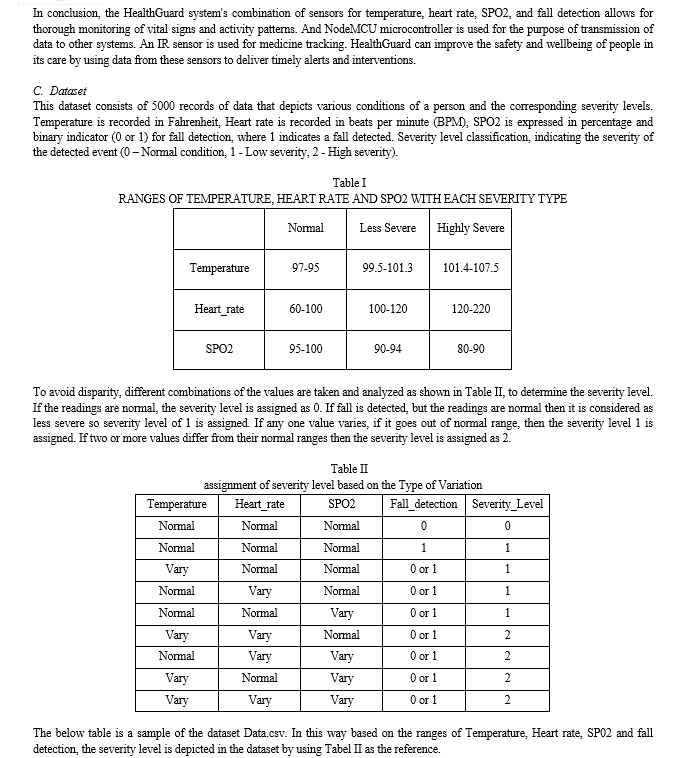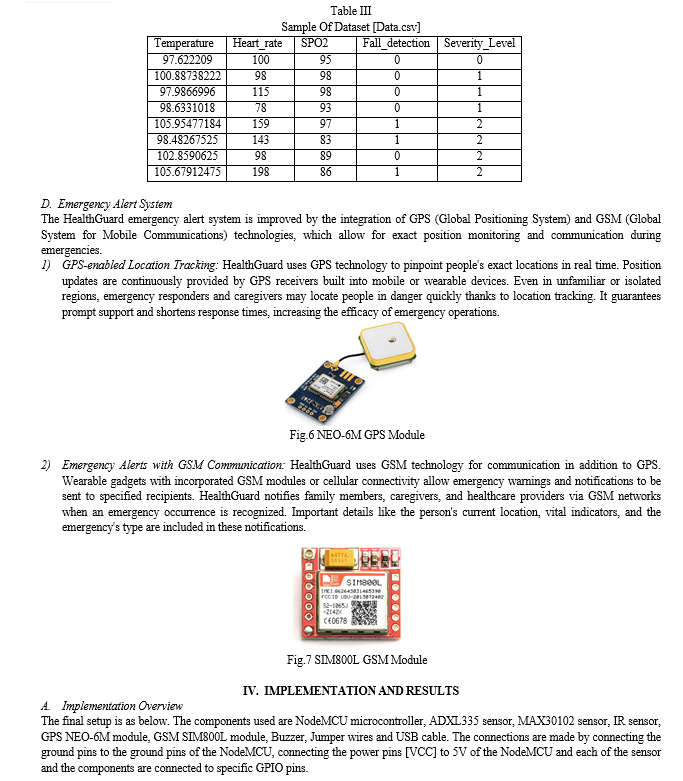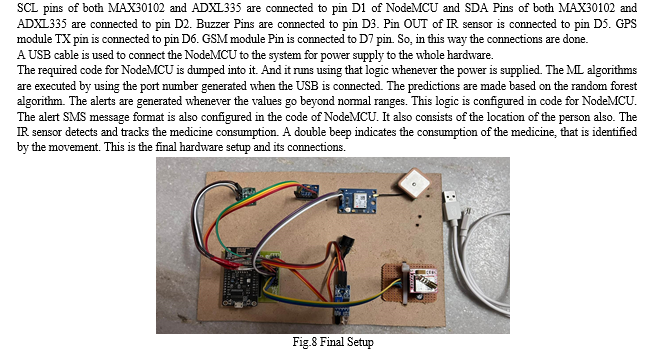Ijraset Journal For Research in Applied Science and Engineering Technology
- Home / Ijraset
- On This Page
- Abstract
- Introduction
- Conclusion
- References
- Copyright
HealthGuard: Real-Time Health Monitoring and Emergency Alert System
Authors: Alekhya Bheemala, Sravani Chennupati, Chaitanya Kola, Pavanvamsi Chimmiri, Manjusha Dudipalla, Snehitha Koganti, Jaswanth Thotakura
DOI Link: https://doi.org/10.22214/ijraset.2024.58657
Certificate: View Certificate
Abstract
In today\'s fast-paced world, the need for continuous health monitoring and rapid response to emergent medical situations is paramount. \"HealthGuard\" is a cutting-edge real-time health monitoring and emergency alert system designed to address this critical need. Leveraging the power of IoT sensors and advanced data analytics, HealthGuard offers a comprehensive solution for tracking and responding to individual\'s health conditions, ensuring timely intervention when necessary. This system employs a network of sensors to continuously collect data on key physiological parameters. HealthGuard utilizes state-of-the-art algorithms to analyze this data in real-time, enabling the early detection of anomalies and stress-indicating patterns. It sends instant alerts to medical professionals, nearby healthcare facilities, or emergency services when critical thresholds are breached. This ensures that individuals receive prompt medical attention when their health is at risk, potentially saving lives in emergency situations.
Introduction
I. INTRODUCTION
In recent years, the integration of advanced technologies into healthcare systems has revolutionized the delivery and monitoring of healthcare. Realtime monitoring systems have emerged as a key component to ensure prompt intervention and improve the outcomes of patients. Among these, the "HealthGuard" system provides comprehensive real time monitoring and emergency alert capabilities in addition to major advances in healthcare technology.
In order to meet the critical need for continuous monitoring of patient’s health parameters and timely detection of emergency situations, the HealthGuard system is designed. HealthGuard provides healthcare providers with unique insights into patient’s well-being through the use of a combination of sensors, data analytics, and communication technologies. This enables pre-emptive intervention when needed. Critical signs such as heart rate, oxygen saturation, temperature and fall detection is one of the major features of HealthGuard.
These parameters, which ensure that there is no interruption of the patient’s daily activity, shall be monitored constantly via non-invasive sensors. The collected data shall be transmitted in a secure manner to a central monitoring station, where it shall be analysed in real time by algorithms.
In addition to real-time monitoring, HealthGuard has an automated alert system that will automatically sound an alarm in the event of crises or unexpected readings. Instant alerts are sent to family members and healthcare professionals through GPS and GSM modules so they may respond swiftly and receive medical aid immediately.
II. LITERATURE REVIEW
In the paper [1], the authors of the paper built a health monitoring system which monitors the temperature, humidity and pulse rate of the patients. A heart beat sensor is used to calculate pulse rate and DHT11 sensor is used to calculate the temperature and humidity of a patient. This author used Node MCU as microcontroller, a Wi-Fi module and LCD screen to display data in digital format.
From [2], a system is proposed that provides the doctors, a tele-monitoring platform that monitors the patients continuously. The sensor data which is collected is transferred to a server using a device. The doctors can monitor this data through the server more easily. A patient’s medical history, which includes the medical reports and medications and its timings are stored in the cloud for the future purpose. Also proposed a system that enables monitoring of their parents if they are living abroad.
The paper [3] explains the development of a medicine reminder and dispensing machine, which helped the doctors, nurses and caregivers to help patients without being in contact with them during the covid pandemic situation. The track of medicine consumption timestamps is stored in a SD card for future reference by doctors. It is useful for elders who forget to take their medicines as per prescription by the doctors for their medical conditions.
When the world is hit by Covid-19, there is a need for a monitoring system described in [4], the doctors cannot go in contact with patient. This system monitors a patient who is in stage 1. It uses temperature, blood oxygen level and heart rate sensors to gather data and store in a server. In case of any emergencies like a drop in blood oxygen levels, an alert is immediately sent so that a life can be saved beforehand. The system generates alerts to the nearest hospitals in case of emergency.
The paper [5] concentrates on elderly people, because falls in that age can lead to severe situations too. So, monitoring that is really important and they need immediate help and medication as soon as possible which might sometimes save their lives too. This system uses a classifier to detect falling using the image descriptors or the features.
III. DESIGN AND METHODOLOGY
A. System Architecture
HealthGuard, uses a couple of sensors to collect the data from a human body. Temperature, heart rate, SPO2 and fall detection readings are obtained by using two sensors. MAX30102 sensor is used to collect the temperature, heart rate and SPO2 readings from a human body. ADXL345 sensor is used to determine the fall detection. The data that is generated by sensors is stored to a database. The data that is stored is used for training the machine learning model and the predictions are made accordingly. The results are displayed on the web application and the alerts are generated whenever the readings exceed the threshold. The SMS alerts are raised when the fluctuations in the readings are witnessed. GPS alerts are raised whenever the fall is detected.

B. Real-Time Monitoring
HealthGuard gathers real-time data on vital signs and other health metrics using a variety of sensors and wearable technology. These sensors could be accelerometers, temperature sensors, pulse oximeters and heart rate monitors. HealthGuard uses machine learning techniques to instantly assess the streamed data after it has been received. By taking severity level into account, these algorithms find patterns, trends, and anomalies in the health data, enabling early identification of possible health hazards or emergency situations.
Several sensors are integrated by the HealthGuard system to provide thorough real-time health monitoring and emergency detection. An overview of the sensors used is provided below:
1) MAX30102: The MAX30102 sensor is a multipurpose sensor that measures temperature, heart rate and oxygen saturation (SPO2). It makes use of photoplethysmography (PPG) technology to identify variations in blood volume inside the tissue's microvascular bed. HealthGuard can identify anomalies such as irregular heart rhythms or low oxygen saturation, and provide early warning indicators of possible cardiac events or respiratory problems by continually monitoring heart rate and SPO2 levels.




A. Comparative Machine Learning Algorithms
For the prediction part, four different machine learning algorithms are compared and analyzed and the one that gives good accuracy with the data is selected to evaluate the severity level of the new sensor data. The algorithms that are used:
- Logistic Regression: A probabilistic framework for severity level prediction is provided by logistic regression, which models the relationship between input features and the probability of various severity levels. The probabilistic output from logistic regression is projected probabilities for every severity level. Decision-makers can use the anticipated probability to make well-informed decisions and gain a sophisticated grasp of the uncertainty around severity level projections. Interpretability is provided using logistic regression, which enables analysis of the coefficients corresponding to each input feature and their influence on severity level prediction.
- SVM: SVMs can be trained on historical data with severity labels and features pertaining to emergencies or medical issues. Based on its attributes, the SVM model learns to classify an instance's severity level. SVMs can forecast severity levels across several categories or levels since they can perform multi-class classification jobs. Severity levels in healthcare can be classified as normal, moderate, or severe. Based on input features, SVMs can be trained to categorize occurrences into one of three severity levels. SVMs can enhance severity level prediction by using feature engineering approaches to extract pertinent information from raw data. Through constant updating of the model with feedback and incoming data, the system may adjust to changing circumstances and gradually increase prediction accuracy.
- KNN: Based on comparable examples in the dataset, KNN can be used to categorize health disorders or emergency scenarios according to their severity. A new instance's severity level is determined by the procedure using the majority class of its k-nearest neighbours. Based on the severity levels of comparable cases in the dataset, KNN can forecast a patient's condition's level in a health monitoring system. Healthcare professionals can use this information to determine the seriousness of the condition and to distribute resources appropriately. When datasets have unequal severity levels, meaning that certain classes occur more frequently than others, KNN could show biases in favour of the dominant class. Class imbalance problems can be addressed and the model's capacity to forecast severity levels across all classes improved by employing strategies like oversampling, under sampling, or the use of class weights. The selection of the KNN's k-value, or number of nearest neighbours, can have a substantial impact on prediction accuracy, improve the model's generalization capabilities, and reduce overfitting or underfitting problems.
- Random Forest: Random Forests can be trained to categorize emergency situations or medical illnesses according to the severity using a variety of variables, including symptoms, vital signs, demographic data, and environmental aspects. Random Forests enable accurate classification by capturing intricate correlations between severity levels and input variables through the construction of an ensemble of decision trees. Multi-class classification jobs can be handled using Random Forests, which makes it possible to anticipate severity levels across several categories or levels. The ability to classify severity levels into various categories or classes—from minor occurrences to severe emergencies—is made possible by this flexibility. By offering insights into the significance of features, Random Forests facilitate the identification of critical elements that influence the prediction of severity levels.

C. Performance Evaluation Metrics
- Precision: Precision is a metric that expresses how well the model predicts favourable outcomes. Within the framework of a health monitoring system, precision would represent the percentage of anticipated health emergencies or alerts that actually occur. High precision indicates a high likelihood of accuracy when the system sounds an alert.
- Recall: Recall, sometimes referred to as sensitivity, gauges how well a model can accurately identify every pertinent incident. Recall in the context of health monitoring would mean the percentage of real health emergencies or alarms that the system accurately identifies. A high recall rate indicates that the majority of real emergencies and alarms are successfully captured by the system.
- F1-Score: The harmonic mean of recall and precision is the F1-score. It offers a harmony between recall and precision. The F1-score is frequently employed because it takes into account both false positives (precision) and false negatives (recall) in scenarios where both accuracy and recall are crucial. Good overall performance in terms of recall and precision is indicated by a high F1-score.
 \
\
V. ACKNOWLEDGMENT
The timely completion of this journal paper on emergency alert and real-time health monitoring systems is largely due to the tremendous assistance of various academics and researchers in the field of healthcare technology. Their diversity of knowledge and proficiency has greatly improved the quality of our investigation. We would like to express our heartfelt gratitude to the authors of the sources that were analysed for their hard work, which has resulted in insightful information, data, and methodology that have made it easier to develop and validate our real-time health monitoring and emergency alerting system.
Conclusion
Utilizing state-of-the-art hardware and machine learning algorithms, the \"HealthGuard\" real-time health monitoring and emergency alert system represents a substantial advancement in healthcare technology by offering thorough monitoring and prompt intervention for people with health concerns. The NodeMCU microcontroller is used in conjunction with sensors MAX30102 and ADXL335 to continuously monitor physiological parameters and movement. This allows the system to provide real-time insights into the health status of the user. We conducted extensive testing and research to evaluate the effectiveness of several machine learning algorithms, such as Random Forest, SVM, KNN, and Logistic Regression. The Random Forest algorithm was surprisingly the best performer, exhibiting the highest level of accuracy in severity level prediction. This demonstrates how well ensemble learning approaches handle complicated health data collected from sensors. Furthermore, by informing caregivers or emergency services of the user\'s precise location, the integration of GPS location-based SMS alerts utilizing GPS NEO-6M and GSM SIM800L modules guarantees quick reaction during emergencies. This function improves the system\'s performance under dire circumstances and may even save lives. Furthermore, the system gains an additional layer of capability with the addition of an IR sensor to detect medication usage. HealthGuard\'s ability to monitor medication adherence allows it to send out alerts when a prescription is not taken as directed, allowing for proactive intervention and better patient care overall. This is how HealthGuard works.
References
[1] Bhardwaj, Harsh, Kartik Bhatia, Anjali Jain and Neelam Verma. “IOT Based Health Monitoring System.” 2021 6th International Conference on Communication and Electronics Systems (ICCES) (2021): 1-6. [2] Mukherjee, Srijani & Dolui, Koustabh & Datta, Soumya Kanti. (2014). Patient Health Management System Using e-Health Monitoring Architecture. 400-405. 10.1109/IAdCC.2014.6779357. [3] Chandana, N. Siri, Mayura Kumar, Megha, Guruprasada Shridhar Hegde and K Shashi Raj. “IoT based Medicine Reminder and Dispensing Machine.” 2022 Second International Conference on Artificial Intelligence and Smart Energy (ICAIS) (2022): 1060-1066. [4] Sabukunze, Igor Didier, Djoko Budiyanto Setyohadi and Margaretha Sulistyoningsih. “Designing An Iot Based Smart Monitoring and Emergency Alert System for Covid19 Patients.” 2021 6th International Conference for Convergence in Technology (I2CT) (2021): 1-5. [5] Ali, Syed Farooq, Muhammad Muaz, A. Fatima, Fatima Idrees and Noman Nazar. “Human fall detection.” INMIC (2013): 101-105. [6] Mubibya, Gael S., Sinda Besrour and Jalal Almhana. “A Real-Time IoT System and ML algorithms: A Comparative Study.” ICC 2022 - IEEE International Conference on Communications (2022): 5262-5267. [7] Das, Manab Kumar, Priti Deb, and Indrajit De. 2024. “Remote Patient Health Monitoring Frameworks Using IoT and ML: A Comparative Study”. International Journal of Intelligent Systems and Applications in Engineering 12 (13s):367-72. [8] Mubibya, Gael S., Sinda Besrour and Jalal Almhana. “A Real-Time IoT System and ML algorithms: A Comparative Study.” ICC 2022 - IEEE International Conference on Communications (2022): 5262-5267. [9] Mohd Ismail, Mohd Ismifaizul & Dziyauddin, Rudzidatul & Salleh, Noor & Ahmad, Robiah & Bin Azmi, Marwan & Mad Kaidi, Hazilah. (2018). Analysis and Procedures for Water Pipeline Leakage using Three-axis Accelerometer Sensors: ADXL335 and MMA7361. IEEE Access. PP. 1-1. 10.1109/ACCESS.2018.2878862. [10] Bharavi, U and Rao M Sukesh. “Design and development of GSM and GPS tracking module.” 2017 2nd IEEE International Conference on Recent Trends in Electronics, Information & Communication Technology (RTEICT) (2017): 283-288.
Copyright
Copyright © 2024 Alekhya Bheemala, Sravani Chennupati, Chaitanya Kola, Pavanvamsi Chimmiri, Manjusha Dudipalla, Snehitha Koganti, Jaswanth Thotakura. This is an open access article distributed under the Creative Commons Attribution License, which permits unrestricted use, distribution, and reproduction in any medium, provided the original work is properly cited.

Download Paper
Paper Id : IJRASET58657
Publish Date : 2024-02-28
ISSN : 2321-9653
Publisher Name : IJRASET
DOI Link : Click Here
 Submit Paper Online
Submit Paper Online

